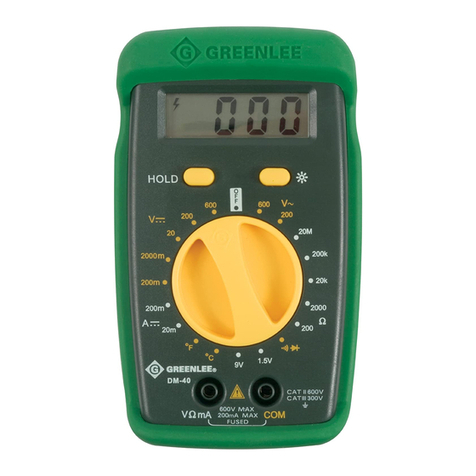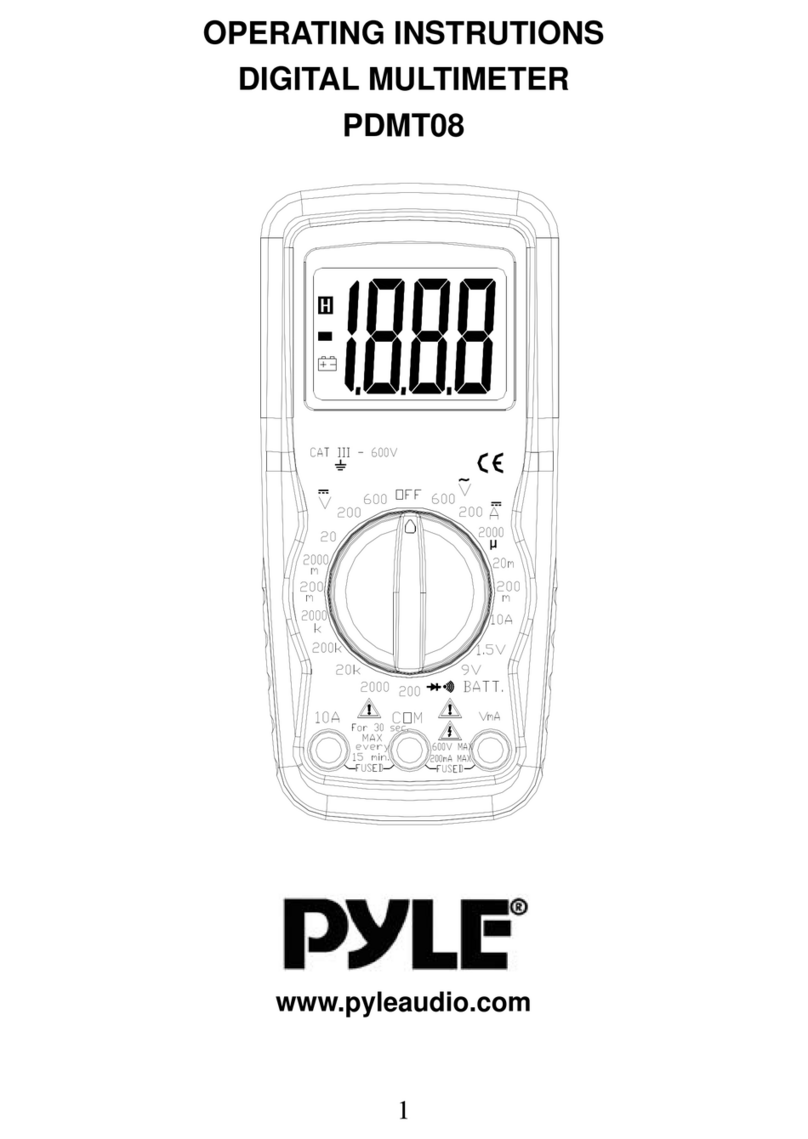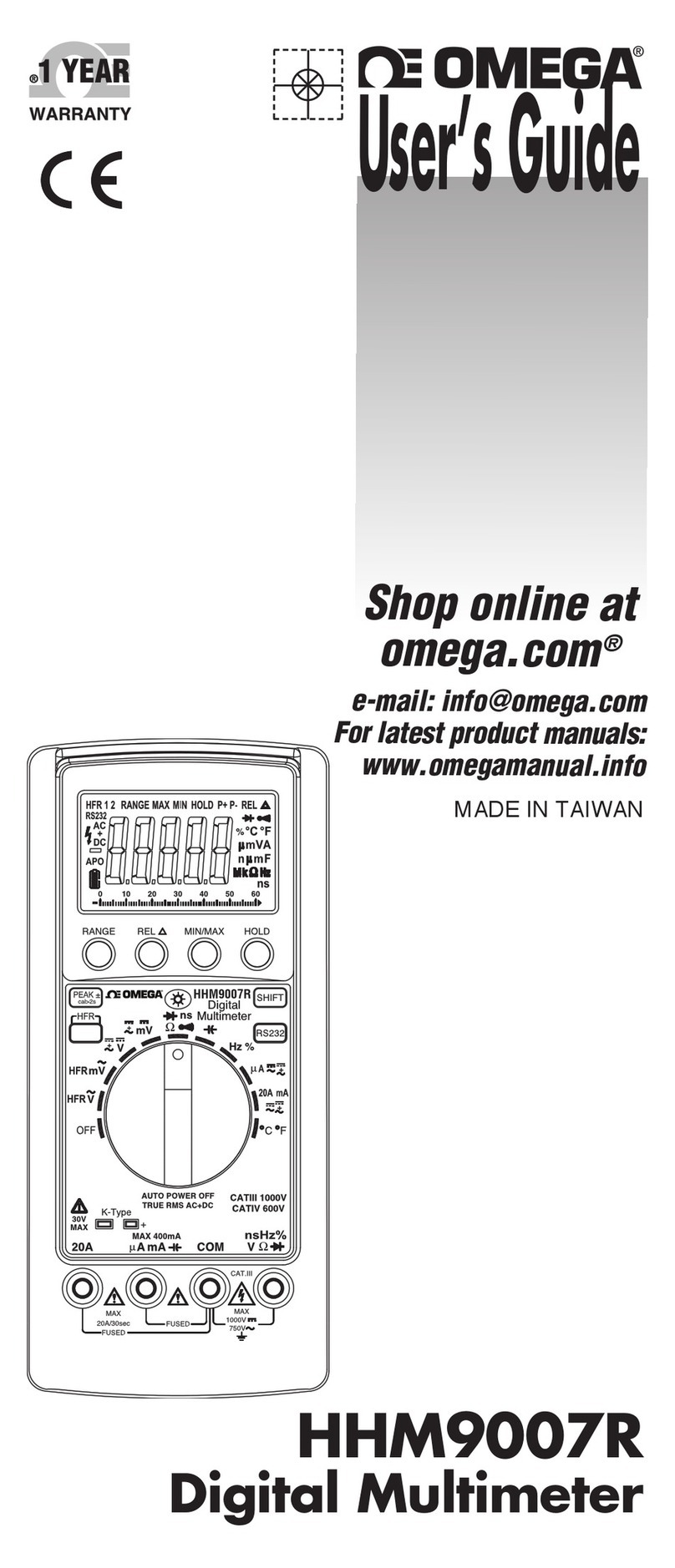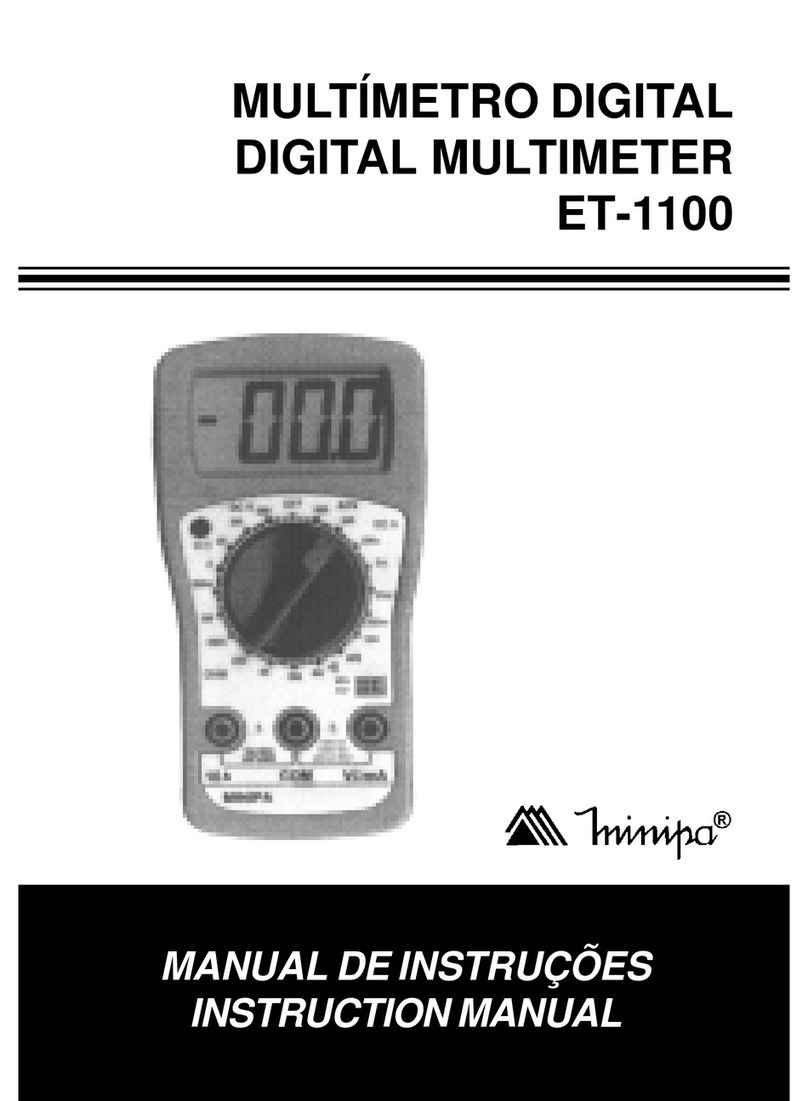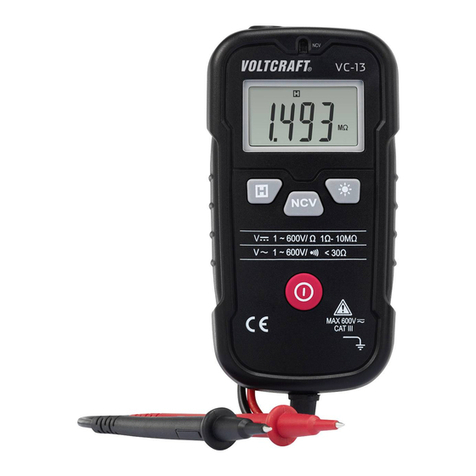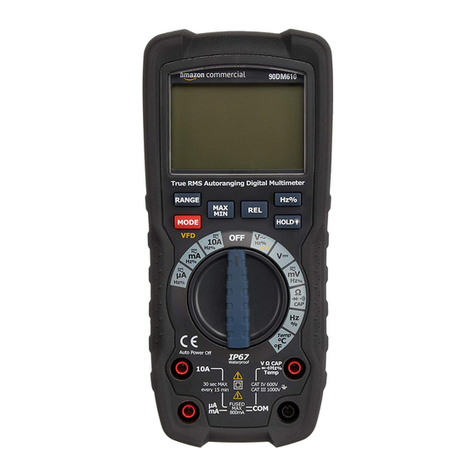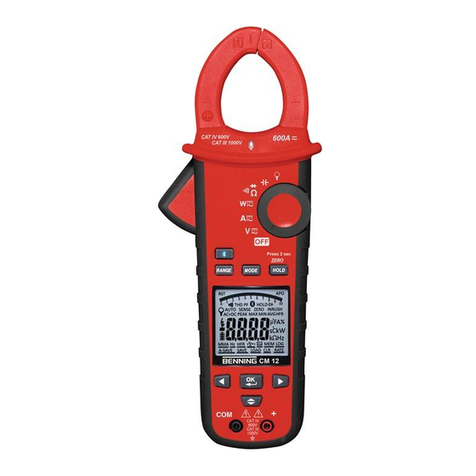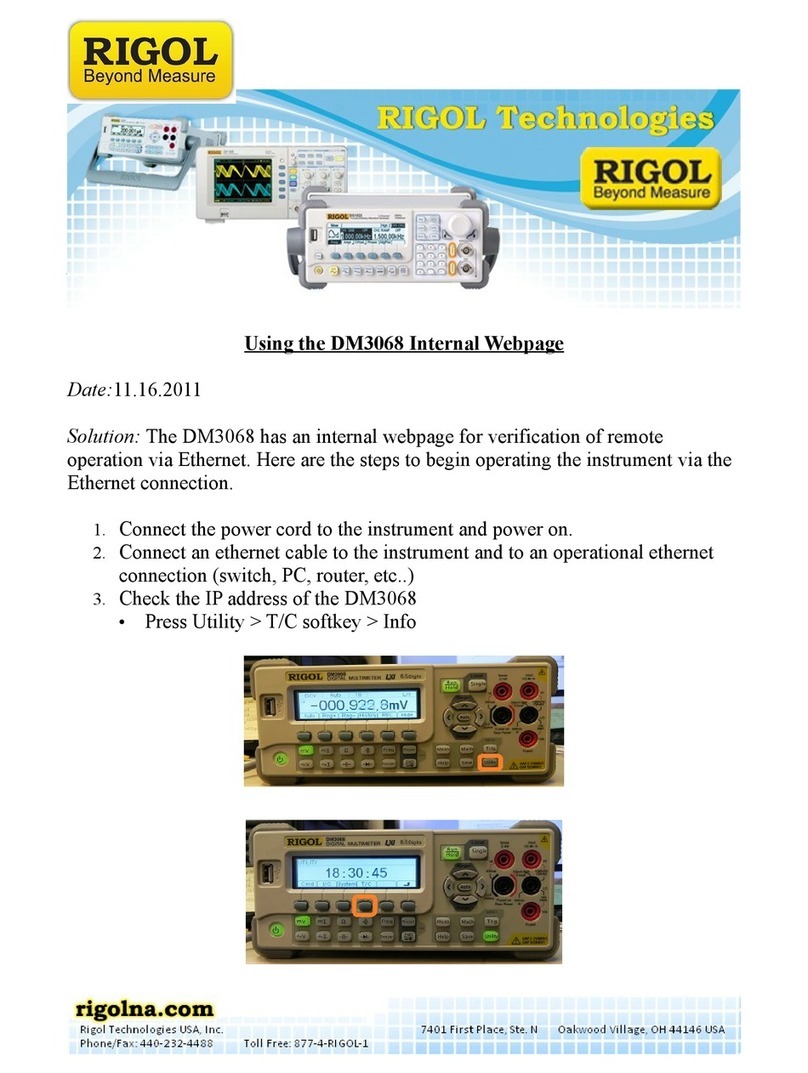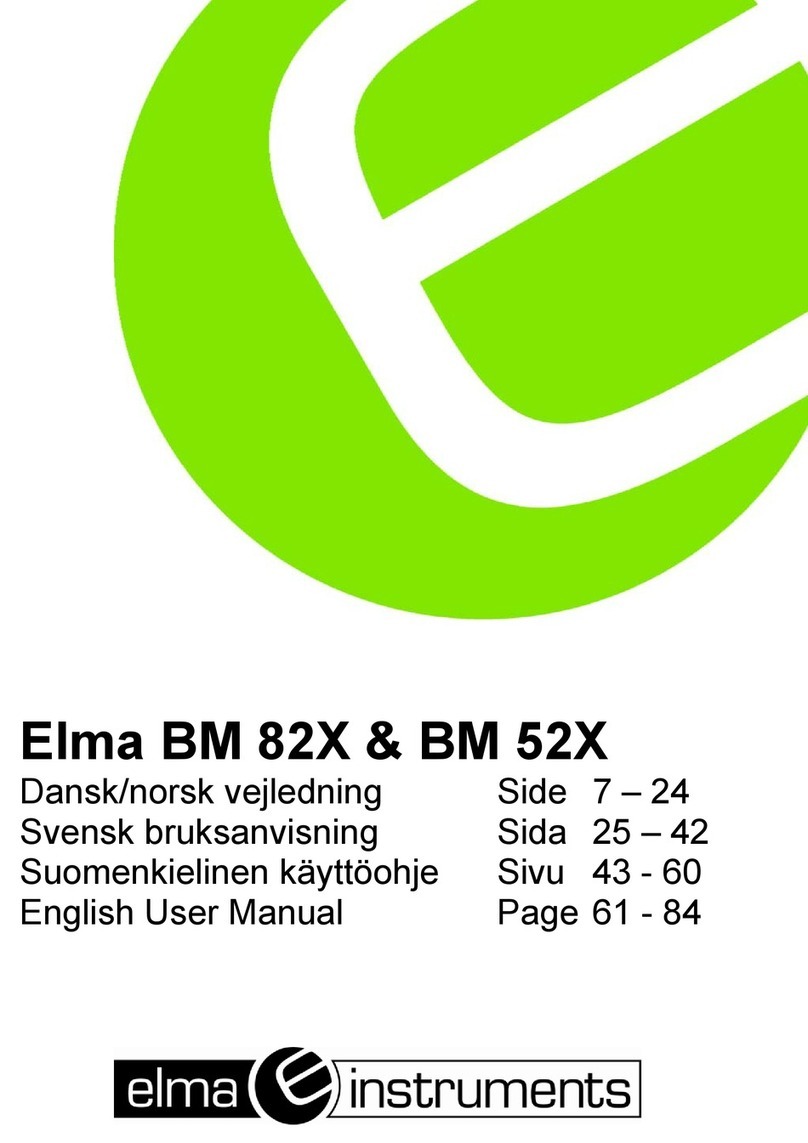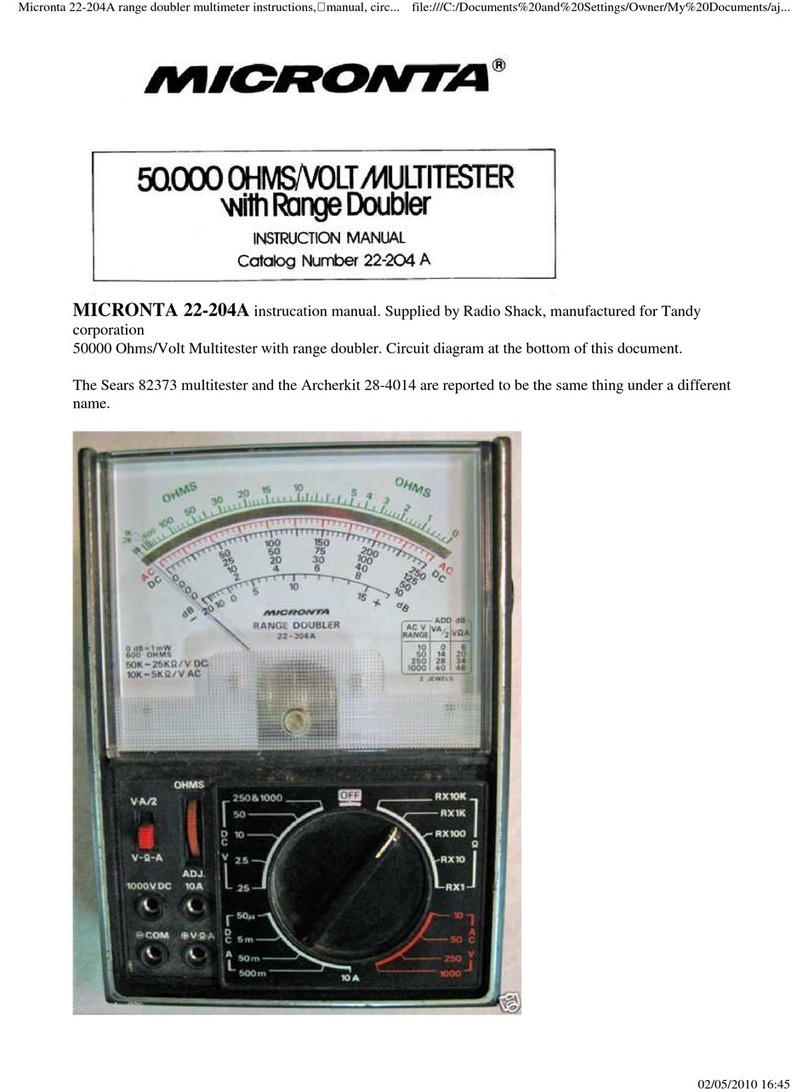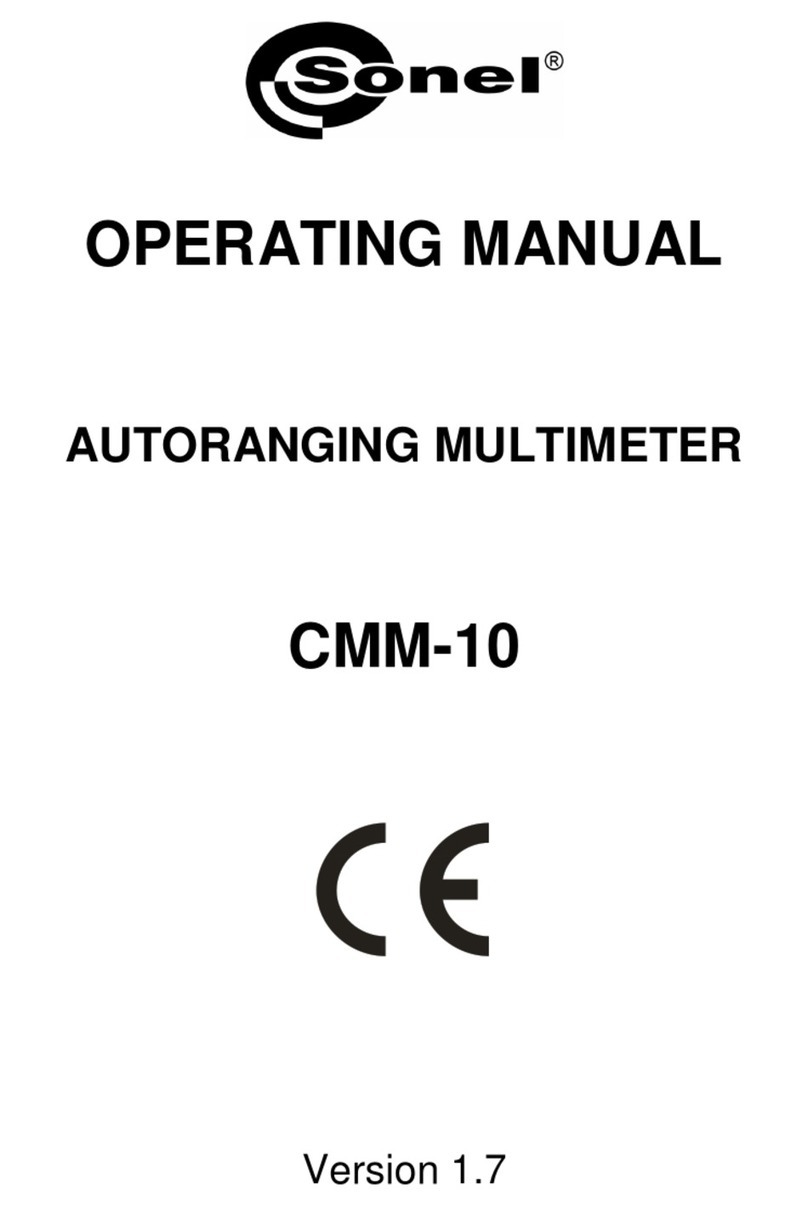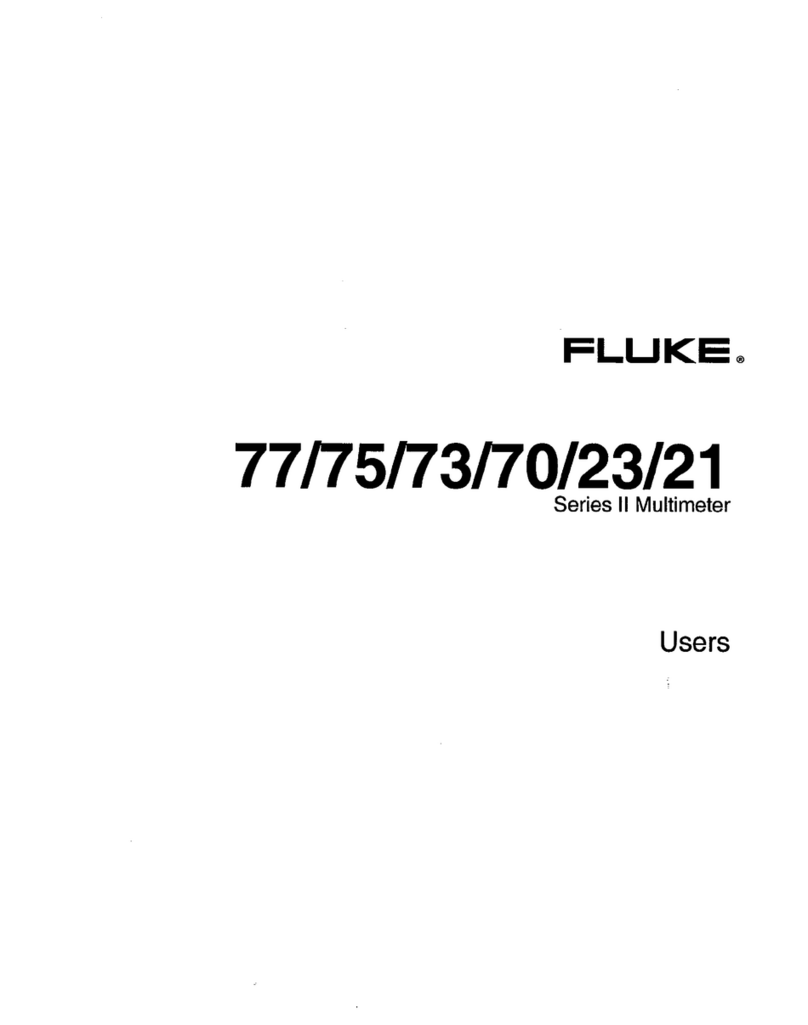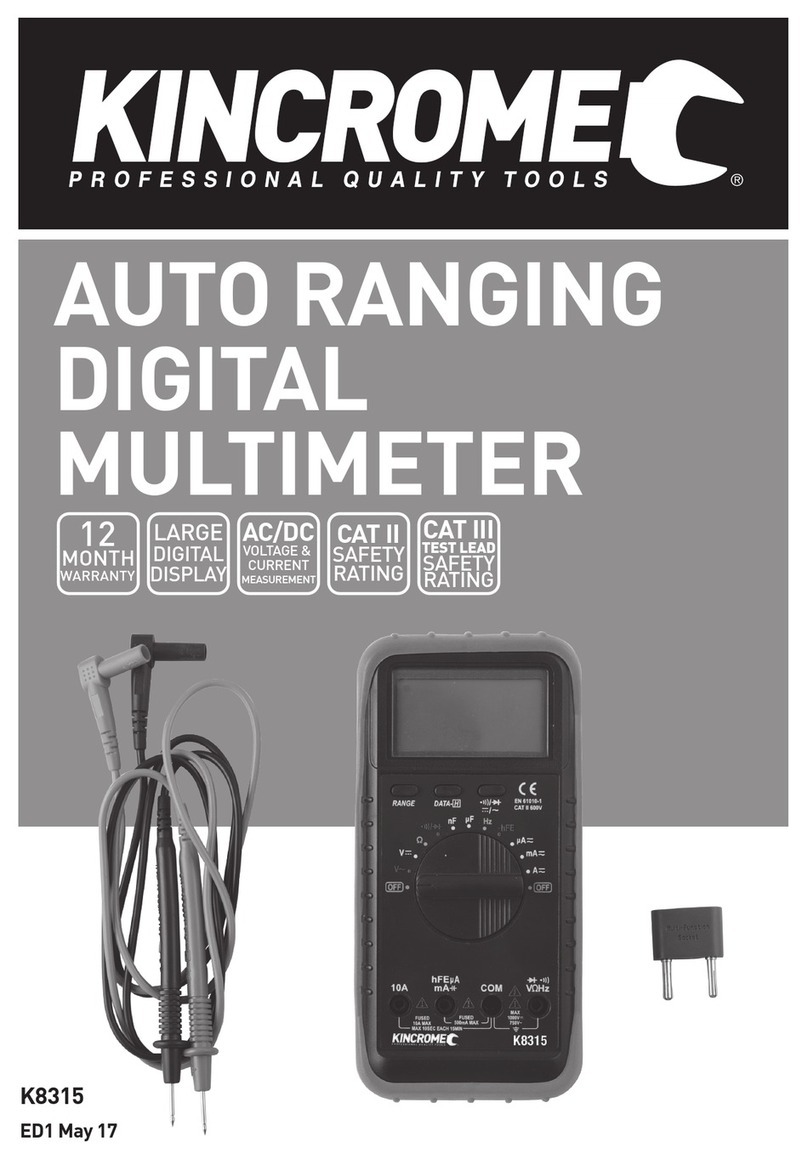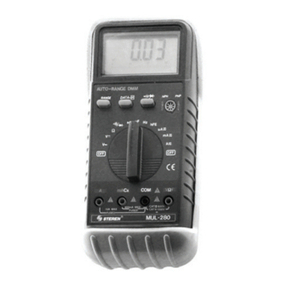Tektronix, Inc. DMM4050 Use and care manual

DMM4040 and DMM4050
Digital Multimeter
Technical Reference
077-0362-01

Copyright © Tektronix. All rights reserved. Licensed software products are owned by Tektronix
or its subsidiaries or suppliers, and are protected by national copyright laws and international
treaty provisions.
Tektronix products are covered by U.S. and foreign patents, issued and pending. Information in
this publication supersedes that in all previously published material. Specifications and price
change privileges reserved.
TEKTRONIX and TEK are registered trademarks of Tektronix, Inc.
Contacting Tektronix, Inc.
Tektronix, Inc.
14200 SW Karl Braun Drive
P.O. Box 500
Beaverton, OR 97077
USA
For product information, sales, service, and technical support:
- In North America, call 1-800-833-9200.
- Worldwide, visit www.tektronix.com to find contacts in your area.

Table of Contents
Chapter Title Page
1 Introduction and Specifications......................................................... 1-1
Introduction........................................................................................................ 1-3
General Safety Summary................................................................................... 1-4
To Avoid Fire or Personal Injury.............................................................. 1-4
Symbols and Terms................................................................................... 1-7
Safety and Electrical Symbols .................................................................. 1-7
Description of IEC 61010 Measurement Categories................................. 1-8
Organization of the Calibration Manual............................................................ 1-8
Chapter 1 – Introduction and Specifications ................................................. 1-9
Chapter 2 – General Maintenance ................................................................. 1-9
Chapter 3 – Performance Test and Calibration.............................................. 1-9
Operating Instructions........................................................................................ 1-9
Accessories ........................................................................................................ 1-9
General Specifications ....................................................................................... 1-11
Power............................................................................................................. 1-11
Dimensions.................................................................................................... 1-11
Display........................................................................................................... 1-11
Environment .................................................................................................. 1-11
Triggering...................................................................................................... 1-11
Memory ......................................................................................................... 1-11
Math Functions.............................................................................................. 1-11
Electrical........................................................................................................ 1-12
Remote Interfaces.......................................................................................... 1-12
Warranty........................................................................................................ 1-12
Electrical Specifications .................................................................................... 1-12
DC Voltage Specifications ............................................................................ 1-12
Input Characteristics.................................................................................. 1-12
4050 Accuracy .......................................................................................... 1-13
4040 Accuracy .......................................................................................... 1-13
Additional Errors....................................................................................... 1-13
AC Voltage Specifications ............................................................................ 1-13
Input Characteristics.................................................................................. 1-14
4040/4050 Accuracy ................................................................................. 1-14
Additional Low Frequency Errors............................................................. 1-15
Resistance...................................................................................................... 1-15
i

DMM4040 and DMM4050
Technical Reference
Input Characteristics.................................................................................. 1-15
4040/4050 Accuracy ................................................................................. 1-16
Additional Ohms Errors............................................................................ 1-16
DC Current .................................................................................................... 1-16
Input Characteristics.................................................................................. 1-16
Accuracy (4040/4050)............................................................................... 1-17
Additional Current Errors ......................................................................... 1-17
AC Current .................................................................................................... 1-18
Input Characteristics.................................................................................. 1-18
4040/4050 Accuracy ................................................................................. 1-19
Additional Low Frequency Errors............................................................. 1-20
Frequency ...................................................................................................... 1-20
4040/4050 Accuracy ................................................................................. 1-20
Gate Time vs. Resolution.......................................................................... 1-20
Additional Low Frequency Errors............................................................. 1-20
Capacitance (4050 only)................................................................................ 1-21
Temperature (4050 only)............................................................................... 1-21
Additional Errors........................................................................................... 1-21
Continuity...................................................................................................... 1-21
Diode Test ..................................................................................................... 1-22
Measurement Rates (IEEE488[4])................................................................. 1-22
Measurement Uncertainty.................................................................................. 1-22
Interpreting Accuracy Specifications................................................................. 1-23
24-Hour Accuracy ......................................................................................... 1-23
90-Day and 1-Year Accuracy........................................................................ 1-23
Temperature Coefficients .............................................................................. 1-23
Configuring for Highest Accuracy Measurements ............................................ 1-23
DC Voltage, DC Current, and Resistance Measurements ............................. 1-23
AC Voltage and AC Current Measurements:................................................ 1-23
Frequency and Period Measurements:........................................................... 1-23
2 General Maintenance .......................................................................... 2-1
Introduction........................................................................................................ 2-3
Warranty Repairs and Shipping Information..................................................... 2-3
General Maintenance Information..................................................................... 2-3
Required Equipment...................................................................................... 2-3
Power Requirements...................................................................................... 2-3
Static Safe Handling...................................................................................... 2-3
Cleaning............................................................................................................. 2-4
Fuse Replacement.............................................................................................. 2-4
Line-Power Fuse............................................................................................ 2-4
Current-Input Fuses....................................................................................... 2-5
If the Meter Does Not Turn On.......................................................................... 2-7
Display Tests...................................................................................................... 2-7
Disassembly Procedures .................................................................................... 2-7
General Disassembly..................................................................................... 2-7
Main Chassis Disassembly............................................................................ 2-8
Front Panel Disassembly ............................................................................... 2-8
Assembly Procedures......................................................................................... 2-8
3 Performance Test and Calibration..................................................... 3-1
Introduction........................................................................................................ 3-4
Required Equipment .......................................................................................... 3-4
Test Considerations............................................................................................ 3-6
ii

Contents (continued)
Performance Tests.............................................................................................. 3-6
Volts DC Verification.................................................................................... 3-6
Volts DC Ratio Verification.......................................................................... 3-10
Volts AC and Frequency Verification........................................................... 3-12
4-Wire Ohms Verification............................................................................. 3-15
2-Wire Ohms Verification............................................................................. 3-17
2X4 Test Lead Verification Steps ................................................................. 3-18
Rear Panel Terminal Verification Steps ........................................................ 3-19
Capacitance Verification Steps (DMM4050 only)........................................ 3-21
DC Current Verification Steps ...................................................................... 3-23
AC Current Verification Steps ...................................................................... 3-25
Adjustment (Calibration)................................................................................... 3-27
Unlocking the Meter for Adjustments (Calibration) ..................................... 3-27
Unlocking the Meter for Adjustments Over a Remote Interface................... 3-27
Changing the Calibration Password .............................................................. 3-27
Resetting the Calibration Password............................................................... 3-28
Changing the Calibration Date ...................................................................... 3-29
Equipment for Calibration............................................................................. 3-29
Adjustment Process ....................................................................................... 3-29
Aborting a Calibration Process...................................................................... 3-35
Sample Adjustment Program......................................................................... 3-35
Appendices
A Verification Forms ...................................................................................... A-1
B Example Adjustment Program .................................................................... B-1
iii

DMM4040 and DMM4050
Technical Reference
iv

List of Tables
Table Title Page
1-1. Accessories............................................................................................................. 1-9
2-1. Line Voltage to Fuse Rating................................................................................... 2-5
3-1. Required Test Equipment....................................................................................... 3-4
3-2. DMM4050 DC Volts Verification Steps................................................................ 3-8
3-3. DMM4040 DC Volts Verification Steps................................................................ 3-9
3-4. DMM4050 DC Volts Ratio Verification Steps...................................................... 3-11
3-5. DMM4040 DC Volts Ratio Verification Steps...................................................... 3-11
3-6. DMM4040/4050 AC Volts Verification Steps....................................................... 3-13
3-7. DMM4040/4050 AC Volts Frequency Verification Steps..................................... 3-14
3-8. DMM4040/4050 4-Wire Ohms Verification Steps................................................ 3-16
3-9. DMM4040/4050 2-Wire Ohms Verification Steps................................................ 3-18
3-10. DMM4050 Rear-Panel Terminal Verification Steps (Optional Test).................... 3-20
3-11. DMM4040 Rear-Panel Terminal Verification Steps (Optional Test).................... 3-20
3-12. DMM4050 Capacitance Verification Steps ........................................................... 3-22
3-13. DMM4040/4050 DC Current Verification Steps................................................... 3-24
3-15. DMM4040/4050 Adjustment Steps ....................................................................... 3-29
v

DMM4040 and DMM4050
Technical Reference
vi

List of Figures
Figure Title Page
1-1. IEC 61010 Measurement Category (CAT) Levels................................................. 1-8
2-1. Line Fuse Replacement.......................................................................................... 2-5
2-2. Current Input Fuse Replacement............................................................................ 2-6
3-1. DC Volts Test Equipment Setup with 5520A........................................................ 3-7
3-2. DC Volts Ratio Test Equipment Setup with 5520A and 5720A............................ 3-10
3-3. AC Volts Test Equipment Setup with 5520A........................................................ 3-12
3-4. 4-Wire Ohms Test Equipment Setup ..................................................................... 3-15
3-5. 2-Wire Ohms Test Equipment Setup ..................................................................... 3-17
3-6. Rear-Panel Terminals Equipment Setup ................................................................ 3-19
3-7. Capacitance Equipment Setup................................................................................ 3-21
3-8. 100 mA DC Current Equipment Setup .................................................................. 3-23
3-9. AC Current Equipment Setup ................................................................................ 3-25
3-10. Calibration Jumper Location.................................................................................. 3-28
vii

DMM4040 and DMM4050
Technical Reference
viii

Chapter 1
Introduction and Specifications
Title Page
Introduction........................................................................................................ 1-3
General Safety Summary................................................................................... 1-4
Organization of the Calibration Manual............................................................ 1-8
Chapter 1 – Introduction and Specifications ................................................. 1-9
Chapter 2 – General Maintenance ................................................................. 1-9
Chapter 3 – Performance Test and Calibration.............................................. 1-9
Operating Instructions........................................................................................ 1-9
Accessories ........................................................................................................ 1-9
General Specifications ....................................................................................... 1-10
Power............................................................................................................. 1-10
Dimensions.................................................................................................... 1-10
Display........................................................................................................... 1-10
Environment .................................................................................................. 1-10
Triggering...................................................................................................... 1-10
Memory ......................................................................................................... 1-10
Math Functions.............................................................................................. 1-10
Electrical........................................................................................................ 1-11
Remote Interfaces.......................................................................................... 1-11
Warranty........................................................................................................ 1-11
Electrical Specifications .................................................................................... 1-11
DC Voltage Specifications ............................................................................ 1-11
AC Voltage Specifications ............................................................................ 1-12
Resistance...................................................................................................... 1-14
DC Current .................................................................................................... 1-15
AC Current .................................................................................................... 1-17
Frequency ...................................................................................................... 1-19
Capacitance (4050 only)................................................................................ 1-20
Temperature (4050 only)............................................................................... 1-20
Additional Errors........................................................................................... 1-20
Continuity...................................................................................................... 1-20
Diode Test ..................................................................................................... 1-21
Measurement Rates (IEEE488[4])................................................................. 1-21
Measurement Uncertainty.................................................................................. 1-21
Interpreting Accuracy Specifications................................................................. 1-22
24-Hour Accuracy ......................................................................................... 1-22
1-1

DMM4040/4050
Technical Reference Manual
90-Day and 1-Year Accuracy........................................................................ 1-22
Temperature Coefficients .............................................................................. 1-22
Configuring for Highest Accuracy Measurements ............................................ 1-22
DC Voltage, DC Current, and Resistance Measurements ............................. 1-22
AC Voltage and AC Current Measurements:................................................ 1-22
Frequency and Period Measurements:........................................................... 1-22
1-2

Introduction and Specifications
Introduction 1
Introduction
The DMM4040 and 4050 are 6-1/2 digit, dual-display multimeters designed for
bench-top, field service, and system applications. Their full complement of measurement
functions plus its RS-232, IEEE 488, and Ethernet Remote Interfaces makes these
multimeters ideal candidates for precision manual measurements and use in automated
systems. For portability, these multimeters include a carrying handle that also serves as a
bail for bench top operation.
There are a few additional features in the DMM4050 that are not present in the
DMM4040. These features will be identified with the annotation of “4050 Only” by each
feature that is found only in that model. Separate specification tables are also used to
clarify the differences between these two models.
The following is a list of some of the features and functions:
•Bright, large-digit, wide-viewing-angle display
•Dual display for displaying two properties of an input signal (e.g., ac voltage in one
display and frequency in the other).
•Remote operation via IEEE 488, RS-232, and Ethernet interface.
•Trigger in and measurement-complete out
•Front panel USB port for optional memory
•6-1/2 digit resolution
•Half-rack width
•True rms ac
•2 and 4-wire resistance measurements
•Extended 10 Ωand 1 GΩranges
•Frequency measurements to 1 MHz
•Capacitance measurements (4050 only)
•Temperature measurement (4050 only)
•10 A current capability
•Decibels (dB and dBm) with variable reference impedance and audio power
measurement capability
•Input terminals on both front and rear panels of the meter
•Closed-case calibration (no internal calibration adjustments)
This technical reference manual focuses on performance verification and calibration of
the Tektronix DMM4040 and 4050 Digital Multimeters (hereafter referred to as the
Meter).
1-3

DMM4040/4050
Technical Reference Manual
General Safety Summary
Review the following safety precautions to avoid injury and prevent damage to this
product or any other products connected to it.
To avoid potential hazards, use this product only as specified.
Only qualified personnel should perform service procedures.
While using this product, you may need to access other parts of a larger system. Read the
safety sections of the other component manuals for warnings and cautions related to
operating the system.
This instrument has been designed and tested in accordance with the European standard
publication EN 61010-1:2001 and U.S./Canadian standard publications UL 61010-1 and
CAN/CSA-C22.2 No.61010-1-04. The instrument has been supplied in a safe condition.
This manual contains information and warnings that must be observed to keep the
instrument in a safe condition and ensure safe operation.
To use the instrument correctly and safely, read and follow the precautions in this section
and follow all the safety instructions or warnings given throughout this manual that relate
to specific measurement functions. In addition, follow all generally accepted safety
practices and procedures required when working with and around electricity.
CAT I equipment is designed to protect against transients from high-voltage, low-energy
sources, such as electronic circuits or a copy machine.
CAT II equipment is designed to protect against transients from energy-consuming
equipment supplied from the fixed installtion, such as TVs, PCs, portable tools, and other
houseshold appliances.
To Avoid Fire or Personal Injury
Use Proper Power Cord. Use only the power cord specified for this product and
certified for the country of use.
Use Proper Voltage Setting. Before applying power, ensure that the line selector is in
the proper position for the source being used.
Connect and Disconnect Properly. Do not connect or disconnect probes or test
leads while they are connected to a voltage source.
Ground the Product. This product is grounded through the grounding conductor of the
power cord. To avoid electric shock, the grounding conductor must be connected to earth
ground. Before making connections to the input or output terminals of the product, ensure
that the product is properly grounded.
Observe All Terminal Ratings. To avoid fire or shock hazard, observe all ratings
and markings on the product. Consult the product manual for further ratings information
before making connections to the product.
Do not apply a potential to any terminal, including the common terminal, that exceeds the
maximum rating of that terminal.
Power Disconnect. The power cord disconnects the product from the power source. Do
not block the power cord; it must remain accessible to the user at all times.
Do Not Operate Without Covers. Do not operate this product with covers or panels
removed.
1-4

Introduction and Specifications
General Safety Summary 1
Do Not Operate With Suspected Failures. If you suspect that there is damage to this
product, have it inspected by qualified service personnel.
Avoid Exposed Circuitry. Do not touch exposed connections and components when
power is present.
Use Proper Fuse. Use only the fuse type and rating specified for this product.
Keep Product Surfaces Clean and Dry.
Warning
To avoid possible electric shock, personal injury, or death, read
the following before using the Meter.
•Use the Meter only as specified in this manual, or the
protection provided by the Meter might be impaired.
•Do not use the Meter in wet environments.
•Inspect the Meter before using it. Do not use the Meter if it
appears damaged.
•Inspect the test leads before use. Do not use them if
insulation is damaged or metal is exposed. Check the test
leads for continuity. Replace damaged test leads before
using the Meter.
•Verify the Meter's operation by measuring a known voltage
before and after using it. Do not use the Meter if it operates
abnormally. Protection may be impaired. If in doubt, have
the Meter serviced.
•Whenever it is likely that safety protection has been
impaired, make the Meter inoperative and secure it against
any unintended operation.
•Servicing of the Meter should be performed by qualified
service personnel.
•Do not apply more than the rated voltage, as marked on the
Meter, between the terminals or between any terminal and
earth ground.
•While in IEC Measurement Category II environments, do not
apply voltages above 600 V ac to the input of the Meter. See
“Description of IEC 61010 Measurement Categories” later in
this manual.
•Always use the power cord and connector appropriate for
the voltage and outlet of the country or location in which
you are working.
•Always use a power cord with a ground connection and
ensure the ground is properly connected to the power
distribution system.
•Remove test leads from the Meter before opening the case.
•Never remove the cover or open the case of the Meter
without first removing it from the main power source.
1-5

DMM4040/4050
Technical Reference Manual
•Use caution when working with voltages above 30 V ac rms,
42 V ac peak, or 42 V dc. These voltages pose a shock
hazard.
•Use only the replacement fuse(s) specified by the manual.
•Use the proper terminals, function, and range for your
measurements.
•Do not operate the Meter around explosive gas, vapor, or
dust.
•When using probes, keep your fingers behind the finger
guards.
•When making electrical connections, connect the common
test lead before connecting the live test lead; when
disconnecting, disconnect the live test lead before
disconnecting the common test lead.
•Disconnect circuit power and discharge all high-voltage
capacitors before testing resistance, continuity, diodes, or
capacitance.
•Before measuring current, check the Meter's fuses and turn
OFF power to the circuit before connecting the Meter to the
circuit.
•When servicing the Meter, use only specified replacement
parts.
•To prevent damage to the Meter, do not change the position
of the Front/Rear switch while signals are applied to either
the front or rear input terminals.
1-6

Introduction and Specifications
General Safety Summary 1
Symbols and Terms
The following terms and safety and electrical symbols may appear in the manual or on
the product:
A Warning statement identifies conditions or practices that could result in injury
or death.
A Caution statement identifies conditions or practices that could result in damage to
the Meter or equipment to which it is connected.
Warning
To avoid electric shock, personal injury, or death, carefully read
the information under “General Safety Summary” before
attempting to install, use, or service the Meter.
Safety and Electrical Symbols
Symbol Description Symbol Description
Risk of danger. Important
information. See manual. Display ON / OFF and Meter reset.
Hazardous voltage. Voltage > 30 V
dc or ac peak might be present. Earth ground
AC (Alternating Current)
Capacitance
DC (Direct Current)
Diode
or
AC or DC (Alternating or Direct
Current) Fuse
Continuity test or continuity beeper
tone YDigital signal
Potentially hazardous voltage
Maintenance or Service
Double insulated Static awareness. Static discharge
can damage parts.
CAT II Measurement Category II is for
measurements performed on
circuits directly connected to the
low voltage installation.
CAT I Measurement Category I is for
measurements not directly
connected to mains.
1-7

DMM4040/4050
Technical Reference Manual
Description of IEC 61010 Measurement Categories
The IEC 61010 safety standard defines four Overvoltage (Installation) Categories (CAT I
to CAT IV) based on the magnitude of danger from transient impulses as shown in Figure
1-1.
cat_levels.eps
Figure 1-1. IEC 61010 Measurement Category (CAT) Levels
The IEC 61010 Measurement CAT level indicates the level of protection the instrument
provides against impulse withstand voltage.
CAT I equipment is designed to protect against transients from high-voltage, low-energy
sources, such as electronic circuits or a copy machine.
CAT II equipment is designed to protect against transients from energy-consuming
equipment supplied from the fixed installation, such as TVs, PCs, portable tools, and
other household appliances.
CAT III equipment is designed to protect against transients in equipment in fixed
equipment installations, such as distribution panels, feeders and short branch circuits, and
lighting systems in large buildings.
CAT IV equipment is designed to protect against transients from the primary supply
level, such as an electricity meter or an overhead or underground utility service.
Organization of the Calibration Manual
This calibration manual is divided into the following chapters:
1-8

Introduction and Specifications
Operating Instructions 1
Chapter 1 – Introduction and Specifications
This chapter introduces the Tektronix DMM4040 and 4050 Digital Multimeters,
describing their features, and accessories. This chapter also discusses use of the
Calibration Manual and the various conventions used in describing the meter’s circuitry
and presents a complete set of specifications.
Chapter 2 – General Maintenance
Chapter 2 provides maintenance information covering handling, cleaning, and fuse
replacement. Access and reassembly procedures are also explained in this chapter.
Chapter 3 – Performance Test and Calibration
This chapter provides performance verification procedures related to the specifications
presented in Chapter 1. To maintain these specifications, a full adjustment/calibration
procedure is also presented.
Operating Instructions
Full operating instructions are provided in the Tektronix DMM4040/4050 Users Manual.
Reference to these instructions may be necessary during some of the maintenance and
repair procedures presented in this Calibration Manual.
Accessories
Table 1-1 lists the available accessories for the DMM4040 and 4050.
Table 1-1. Accessories
Model / Part
Number Description
TL710
196-3520-00 Premium Test Lead Set
TP750 100 Ohm RTD Temperature Probe (DMM4050 only)
013-0369-00 Calibration fixture; 4 terminal shorting bar
Y8846S Rack Mount Kit Single
Y8846D Rackmount Kit Dual
TL705 2X4 Wire Ohm Precision Test Leads
TL725 2X4 Wire Ohm Tweezers Test Leads
159-0487-00 F2, Fuse, 440 mA, 1000 V, Fast, .406X1.375, Bulk
159-0488-00 F1, Fuse, 11 A, 1000 V, Fast, .406INX1.5IN, Bulk
174-5813-00 USB to RS-232 cable assembly
012-0991-01 GPIB cable; Low EMI; 1 meter
159-0187-00 Fuse, 0.25 A, 250 V AC, slow blow
159-0063-00 Fuse, 0.125 A, 250 V, slow blow
HCTEK4321 Hard case, plastic
AC4000 Soft case, nylon
1-9

DMM4040/4050
Technical Reference Manual
General Specifications
Power
Voltage
100 V Setting ...................................................... 90 V to 110 V
120 V Setting ...................................................... 108 V to 132 V
220 V Setting ...................................................... 198 V to 242 V
240 V Setting ...................................................... 216 V to 264 V
Frequency............................................................... 47 Hz to 440 Hz. Automatically sensed at power-on.
Power Consumption................................................ 28 VA peak (12 Watt average)
Dimensions
Height...................................................................... 88 mm (3.46 in.)
Width....................................................................... 217 mm (8.56 in.)
Depth ...................................................................... 297 mm (11.7 in.)
Weight..................................................................... 3.6 kg (8.0 lb)
Shipping Weight...................................................... 5.0 kg (11.0 lb)
Display
Vacuum Fluorescent Display, dot matrix
Environment
Temperature
Operating............................................................ 0 °C to 55 °C
Storage ............................................................... -40 °C to 70 °C
Warm Up............................................................. 1 hour to full uncertainty specifications
Relative Humidity (non-condensing)
Operating............................................................ 0 °C to 28 °C <90 %
28 °C to 40 °C <80 %
40 °C to 55 °C <50 %
Storage ............................................................... -40 °C to 70 °C <95 %
Altitude
Operating............................................................ 2,000 Meters
Storage ............................................................... 12,000 Meters
Vibration and Shock................................................Complies with MIL-PRF-28800F Class 3.
Triggering
Samples per Trigger ...........................................1 to 50,000
Trigger Delay ......................................................0 s to 3600 s; in 10 µS increments
External Trigger Delay........................................<1 mS
External Trigger Jitter .........................................<500 µS
Trigger Input .......................................................TTL Levels
Trigger Output.....................................................5 V maximum (open collector)
Memory
10,000 measurements, internal, and up to 2 Gigabyte capacity with USB memory module (available separately) through
front-panel USB port
Math Functions
Zero, dBm, dB, MX+B, Offset, DCV ratio and TrendPlot, Histogram, Statistics (min/max/average/standard deviation), and
Limit Test
1-10
This manual suits for next models
1
Table of contents

